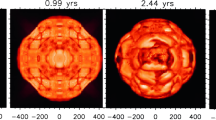Abstract
A region with an appreciable hydrogen gradient arises beneath the base of the convection zone during the evolution of the Sun. This region formes due to the interaction between diffusive chemical segregation and evolutionary motion of the boundary of convective mixing, that is, changes in the mass of the convection zone. A physical model for the evolution of this chemical-composition gradient is proposed, based on a numerical solution of the drift-diffusion equation with discontinuous coefficients, using post-model computations of the evolution of the chemical composition. This model is used to investigate possible traces of the early evolution in the hydrogen profile in the present Sun. Data on this profile can be obtained using helioseimic inversion of the buoyancy frequency in this region. Analysis indicates the presence of an enhanced hydrogen gradient in the region of the tachocline, which could be explained by either additional weak mixing or a greater depth of the solar convection zone when the Sun was on the Zero-Age Main Sequence.
Similar content being viewed by others
References
S. V. Vorontsov and V. N. Zharkov, Itogi Nauki Tekh. Ser. Astron. 38, 253 (1988).
J. Christensen-Dalsgaard, D. O. Gough, and M. J. Thompson, Astrophys. J. 378, 413 (1991).
J. Christensen-Dalsgaard, W. D äppen, S. V. Ajukov, E. R. Anderson, H. M. Antia, S. Basu,V. A. Baturin, G. Berthomieu, B. Chaboyer, S. M. Chitre, A. N. Cox, P. Demarque, J. Donatowicz, W. A. Dziembowski, M. Gabriel, D. O. Gough, D. B. Guenther, J. A. Guzik, J. W. Harvey, F. Hill, G. Houdek, C. A. Iglesias, A. G. Kosovichev, J. W. Leibacher, P. Morel, C. R. Proffitt, J. Provost, J. Reiter, E. J. Rhodes, Jr., F. J. Rogers, I. W. Roxburgh, M. J. Thompson, and R. K. Ulrich, Science 272, 1286 (1996).
J. Christensen-Dalsgaard, in Structure and Dynamics of the Interior of the Sun and Sun-like Stars, Proceedings of the SOHO 6/GONG 98 Workshop, June 1–4, 1998, Boston, Massachusetts, Ed. by S. Korzennik and A. Wilson, ESA SP-418 (ESA Publ. Division, 1998), p. 17.
V. A. Baturin, A. B. Gorshkov, and S. V. Ayukov, Astron. Rep. 50, 1001 (2006).
Ch. Hayashi, R. Hoshi, and D. Sugimoto, Progr. Theor. Phys. Suppl. 22, 1 (1962).
M. Schwarzchild, Structure and Evolution of the Stars (Princeton Univ. Press, Princeton, 1958).
A. A. Samarskii and P. N. Vabishchev, Numerical Techniques for Solving Convection-Diffusion Problems (Editorial URSS, Moscow, 2004) [in Russian].
D. W. Hughes, R. Rosner, and N. O. Weiss, The Solar Tachocline (Cambridge Univ. Press, Cambridge, 2007).
P. Morel and Y. Lebreton, Astrophys. Space Sci. 316, 61 (2008).
S. V. Vorontsov, V. A. Baturin, S. V. Ayukov, and V. K. Gryaznov, Mon. Not. R. Astron. Soc. 430, 1636 (2013).
Author information
Authors and Affiliations
Corresponding author
Additional information
Original Russian Text © V.A. Baturin, A.B. Gorshkov, A.V. Oreshina, 2015, published in Astronomicheskii Zhurnal, 2015, Vol. 92, No. 1, pp. 53–65.
Rights and permissions
About this article
Cite this article
Baturin, V.A., Gorshkov, A.B. & Oreshina, A.V. Formation of a chemical-composition gradient beneath the convection zone and the early evolution of the sun. Astron. Rep. 59, 46–57 (2015). https://doi.org/10.1134/S1063772915010023
Received:
Accepted:
Published:
Issue Date:
DOI: https://doi.org/10.1134/S1063772915010023




